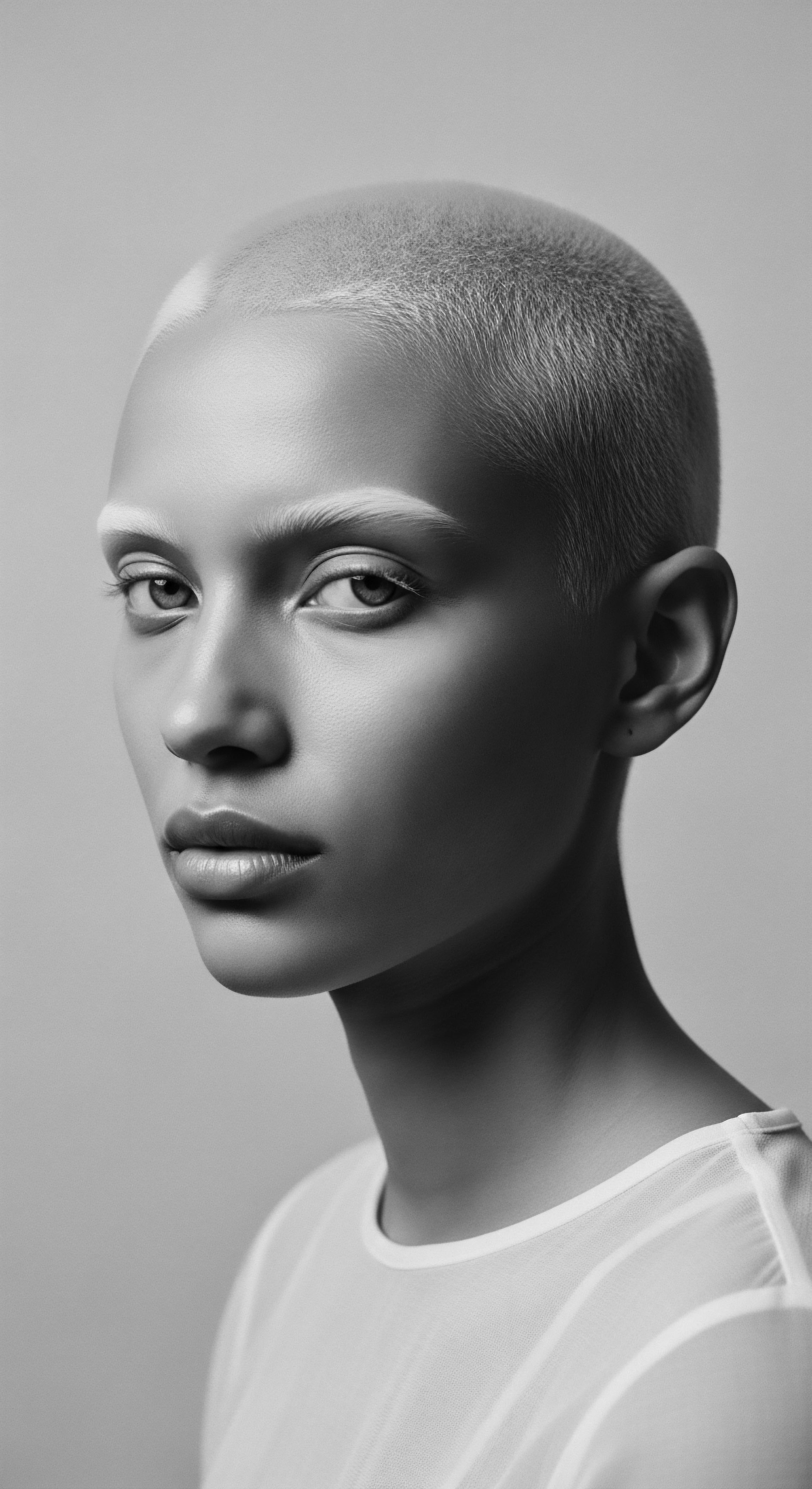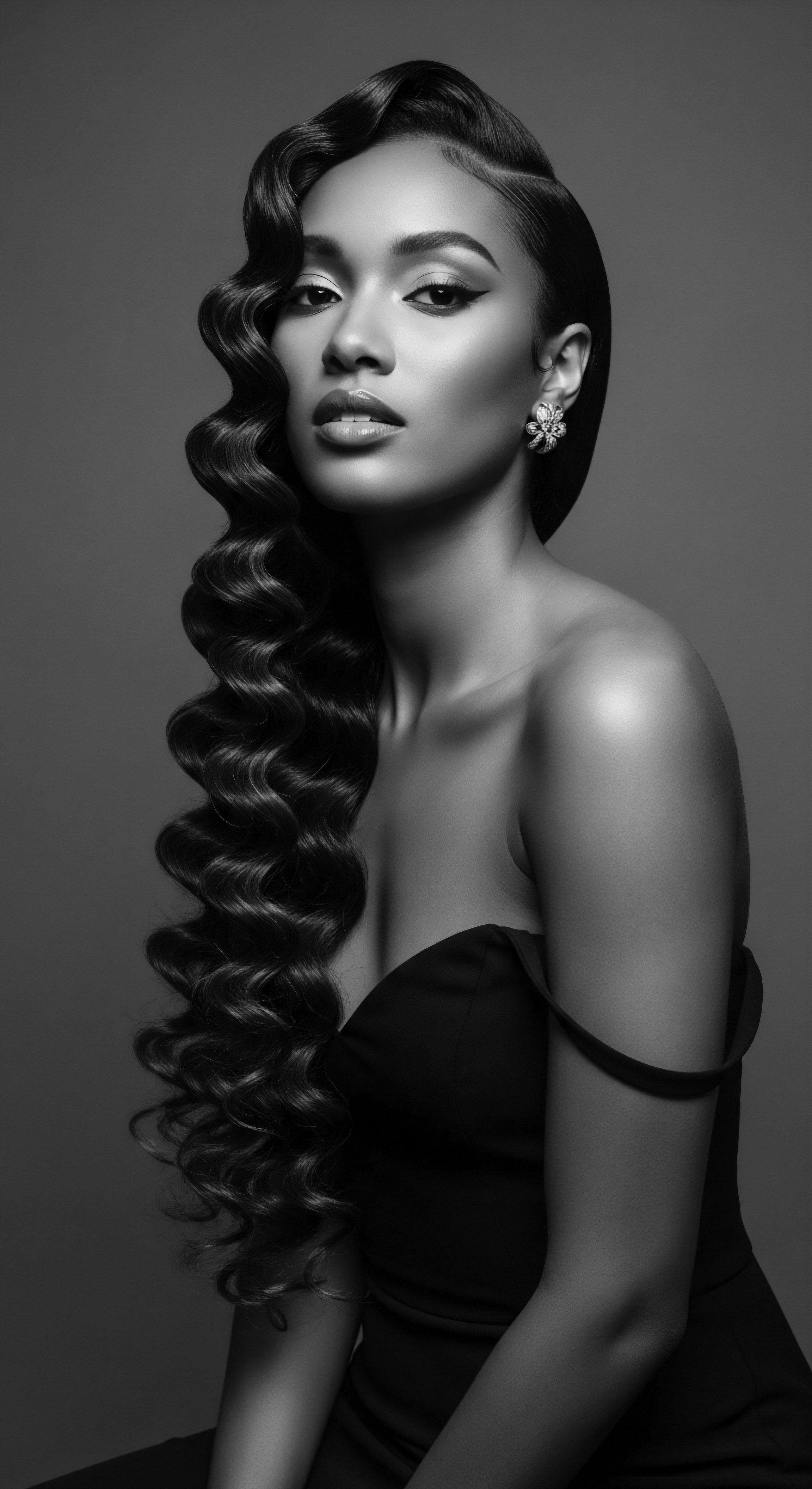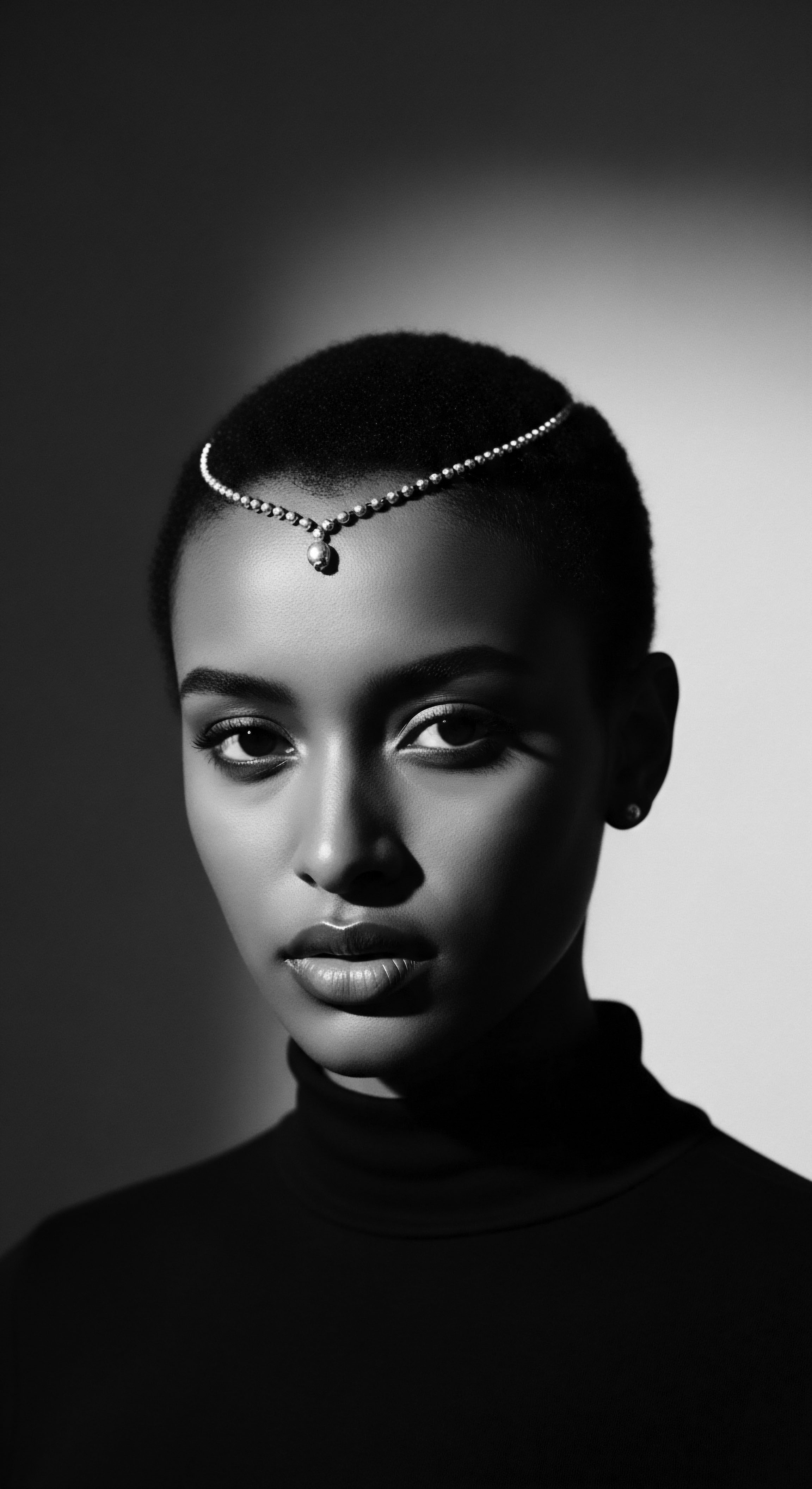
Roots
There exists a whisper, a silent knowing, within each curl and coil of textured hair. It speaks of ancient pathways, of sun-drenched lands, and of hands that nurtured and styled with intention long before current eras. For those with textured hair, particularly individuals of Black and mixed-race descent, this physical aspect of self is rarely just about appearance. Instead, it holds a profound memory, a deep connection to ancestry and the enduring heritage of practices that shaped identity across continents and generations.
To truly understand how ancestral practices influence textured hair identity today, we must first look to the source, to the elemental biology and historical frameworks that defined hair within pre-colonial African societies and beyond. This is a journey that moves beyond surface-level observations, seeking the intricate interplay of science, culture, and spirit that has always defined textured hair.

The Sacred Strand Its Biology and Cultural Context
Hair, at its very core, is a biological marvel. Textured hair, with its unique elliptical follicle shape and varied curl patterns, possesses an inherent strength and a delicate nature. Its spiraled form, which modern science attributes to the distribution of keratin proteins and the shape of the follicle, explains its tendency toward dryness, as natural oils struggle to travel down the curled shaft. Yet, this very structure also grants it an unparalleled ability to coil, stretch, and resist, giving rise to an astonishing array of styles.
Ancestral communities, long before the advent of microscopes, understood this innate character through keen observation and centuries of experiential knowledge. They perceived hair not as a mere collection of fibers, but as a living extension of the self, a conduit to the divine, and a symbol of lineage.
Textured hair, with its unique biological design, served as a profound marker of identity and spiritual connection across ancestral African societies.
In many ancient African cultures, the top of the head was regarded as a spiritual gateway, the closest point to the heavens. Hair, growing from this sacred space, became a significant tool for communication, carrying messages about a person’s age, marital status, social standing, or tribal affiliation. For example, among the Yoruba people of Nigeria, intricate hairstyles often symbolized community roles, and hair was even offered to honor deities during ceremonies. The Maasai of East Africa, for another instance, used distinct hairstyles to denote the various stages of a warrior’s initiation, with shaving and regrowth rituals marking transitions in life.

What Did Traditional Hair Classifications Reveal?
While modern hair classification systems like Andre Walker’s typing system categorize hair into numbers and letters (Type 4C, Type 3A), ancestral societies possessed their own intricate classifications, often expressed through hairstyles themselves. These were not rigid, universal charts but dynamic visual languages tied directly to lived experience and community understanding. A woman’s coiffure might tell a story of her journey, her family’s status, or a significant life event without a single word spoken. This system of non-verbal communication was deeply embedded in daily life.
- Tribal Affiliation ❉ Different ethnic groups across Africa developed distinct hair designs, often influenced by local customs and beliefs. A hairstyle could signal whether someone belonged to the Wolof, Mende, or Ashanti tribes.
- Social Standing ❉ Royalty and elite classes in ancient Egypt wore elaborate wigs and adorned styles, indicating wealth and divine connection. Similarly, the height and elaborateness of a Gele (headwrap) in West Africa often correlated with the wearer’s social standing.
- Life Stages ❉ Specific hairstyles marked transitions from childhood to adulthood, marriage, or mourning. Young Wolof girls might partially shave their heads to indicate they were not yet of marrying age.
These classifications, while unwritten, were universally understood within their cultural contexts, reflecting a nuanced awareness of hair’s capacity to convey identity. The very idea that hair could be such a potent marker is a testament to its cultural value, a value that persisted despite efforts during colonization and enslavement to strip away these expressions.

Echoes of Ancient Lexicons in Contemporary Language
The lexicon surrounding textured hair today carries historical weight. Terms like “cornrows,” although commonplace, have roots in the traditional “canerows” of the Caribbean, a direct nod to their agricultural patterns and the styles’ origins in Africa. The evolution of language used to describe textured hair mirrors its journey through history, from terms of reverence in ancestral lands to derogatory descriptors used during periods of oppression, and then to terms of reclamation in modern times. For instance, archaeological finds from Kush and Kemet (ancient Sudan and Egypt) reveal combs, crafted from wood, bone, and ivory, buried with their owners.
These tools were not merely functional objects; they were considered sacred, often engraved with symbols denoting tribal identity, rank, or even spiritual protection. The presence of such artifacts underlines the historical reverence for both the hair itself and the tools used to tend to it.
Modern hair care discussions often speak of “porosity” and “elasticity,” scientific concepts that explain how hair interacts with moisture and stress. Yet, ancestral practices, without this scientific nomenclature, addressed these very concerns through intuitive methods. The traditional application of nourishing butters and oils, for instance, spoke to an understanding of hair’s need for sealing moisture, an ancient solution to what we now describe as high porosity issues. The persistence of these practices, even as scientific explanations have arrived, demonstrates a continuity of wisdom that spans generations.

Ritual
The practices surrounding textured hair are not simply routines; they are rituals, acts imbued with purpose and a deep connection to living heritage. These rituals, passed down through generations, speak to the care, community, and artistry that have always defined textured hair styling. From the intricate braiding patterns of antiquity to the mindful application of ancestral remedies, the techniques and tools employed today carry the echoes of our forebears, shaping our contemporary relationship with our hair.

How Does Ancestral Styling Inform Our Daily Practices?
The art of textured hair styling is a living archive of human ingenuity and cultural continuity. Many of the protective styles celebrated today—braids, twists, cornrows, and Bantu knots—have direct lineage to ancient African civilizations. These styles were not just aesthetic choices; they served vital practical purposes, shielding hair from environmental elements like sun and dust, minimizing manipulation, and aiding in length retention. Beyond function, they served as powerful visual narratives, communicating social status, age, marital status, or tribal identity.
The meticulous process of braiding or coiling often involved communal gatherings, strengthening familial bonds and intergenerational knowledge transfer. Mothers and elders would impart not only the technical skill but also the stories, values, and oral history of their people.
Consider the cornrow. This style, known as “canerows” in some Caribbean regions, traces its patterns back to agricultural rows and the fields cultivated by enslaved people. These patterns, sometimes intricate and complex, even served as literal maps for escape routes during times of forced displacement, carrying vital information hidden in plain sight.
This historical reality transforms a simple hairstyle into a profound symbol of resilience and resistance, a testament to ancestral creativity under duress. The continuity of this practice today, worn for beauty, protection, and cultural affirmation, directly links contemporary wearers to a legacy of defiance and self-preservation.
Ancestral styling techniques persist as a testament to resilience, beauty, and coded communication across generations of textured hair wearers.
The tradition of hair adornment, too, holds historical depth. Beads, cowrie shells, and other precious materials were historically woven into hairstyles, not only for beauty but also to convey wealth, nobility, or readiness for marriage. These adornments connected the wearer to their environment, their spiritual beliefs, and their community’s aesthetic values.
Today’s resurgence of hair jewelry and decorative elements often reflects a contemporary re-engagement with these ancient expressions, reimagining them for modern identity. The very act of selecting and applying these elements connects the present self to a timeless heritage of self-expression.

What Tools and Transformations Reflect Ancient Ingenuity?
The tools used for hair care and styling have also traveled through time, evolving yet retaining the essence of their ancestral counterparts. The afro comb, for instance, has a lineage spanning over 5,500 years, with archaeological discoveries in Kush and Kemet revealing ornate wooden, bone, and ivory combs. These combs were not mere detangling devices; they were objects of art, symbols of status, and conduits of spiritual meaning.
Their presence in burial sites speaks to the sacred nature of hair and its implements in ancient African traditions. The modern wide-tooth comb or Afro pick, while mass-produced, carries this historical weight, serving as a functional link to a profound past.
| Traditional Tool Hand-carved Combs (wood, bone, ivory) |
| Historical Application Detangling, parting, sculpting; adorned with symbols indicating tribal identity, rank, spiritual protection. |
| Contemporary Parallel or Influence Wide-tooth combs, Afro picks, parting combs; still used for detangling and creating precise sections. |
| Traditional Tool Natural Fibers (wool, cotton, rubber threads for threading) |
| Historical Application Used in styles like Irun Kiko among the Yoruba for protective wrapping, natural hair straightening. |
| Contemporary Parallel or Influence Modern hair threading for stretching hair; extension hair for braids and twists; heatless stretching methods. |
| Traditional Tool Hair Adornments (beads, cowrie shells, precious metals) |
| Historical Application Markers of wealth, marital status, age, or spiritual connection; often incorporated into braids. |
| Contemporary Parallel or Influence Hair jewelry, cuffs, decorative pins, modern beadwork; personal expression and cultural affirmation. |
| Traditional Tool The enduring utility and symbolic weight of these tools connect present-day hair care to a rich ancestral legacy. |
The practice of adding extensions to hair, for volume or length, has deep roots in African traditions. While today we speak of weaves and hair extensions in a globalized beauty context, ancient African women often supplemented their natural hair with fibers, wool, or even other human hair to create elaborate coiffures. These transformations were not about conforming to external standards but about amplifying existing beauty, signifying status, or preparing for ceremonial events. The historical use of wigs in ancient Egypt, crafted from various materials and intricately styled, also speaks to this long-standing practice of hair augmentation for social and aesthetic purposes.
From the communal braiding circles of West Africa to the quiet moments of applying traditional oils, these rituals continue to shape textured hair identity. They underscore a holistic approach to beauty, where the act of styling is intertwined with self-care, community, and the preservation of a living heritage.

Relay
The influence of ancestral practices on textured hair identity today extends beyond mere technique; it shapes our understanding of holistic care, problem-solving, and the very perception of beauty. This enduring wisdom, passed down through generations, forms a dynamic relay, connecting ancient insights to contemporary challenges and aspirations. The science of hair, as we comprehend it now, often validates the intuitive brilliance of practices refined over centuries, revealing a profound congruence between tradition and modern understanding.

What Traditional Ingredients Bolster Hair Wellness Today?
Ancestral communities across Africa and the diaspora cultivated deep knowledge of their local botanicals, recognizing the inherent properties of plants for health and beauty. These ingredients, often sourced directly from the earth, formed the bedrock of hair care regimens. Shea butter, extracted from the nuts of the African shea tree, has been a staple for centuries, revered for its moisturizing and healing capabilities.
Its richness in vitamins and fatty acids addresses the intrinsic dryness of textured hair, sealing in moisture and promoting elasticity – principles that modern science now confirms are crucial for hair health. Similarly, traditional black soap, made from plantain skins and palm oil, offers a gentle yet effective cleanse, avoiding the harsh stripping agents found in many contemporary products that can compromise textured strands.
The Basara Arab women of Chad, known for their exceptional hair length, have long used Chebe powder, a blend of indigenous herbs and seeds. This powder, traditionally applied as a paste, works not by growing hair from the scalp but by preventing breakage and locking in moisture along the hair shaft. This ancient practice speaks directly to a primary challenge for textured hair ❉ length retention. Contemporary interest in Chebe powder, incorporating it into oils and conditioners, represents a revival of traditional solutions for modern needs.
- Shea Butter ❉ Rich in vitamins A and E, providing deep moisture and acting as a protective sealant.
- African Black Soap ❉ A natural cleanser, gentle on the scalp, often made from plantain skins and cocoa pods.
- Chebe Powder ❉ A traditional blend that strengthens hair, minimizes breakage, and enhances length retention.
- Marula Oil ❉ Used in Southern Africa for moisturizing hair and skin, containing beneficial antioxidants.
- Rhassoul Clay ❉ A Moroccan clay known for cleansing and detoxifying the hair and scalp without stripping natural oils.
These natural remedies were not merely utilitarian; their preparation and application were often embedded in social rituals, creating a shared experience of care and community. The selection of particular oils and herbs was guided by generations of observation, a profound empirical science that predates formal laboratories. This collective wisdom, sometimes referred to as a “grammar of hair” (Rosado, 2003), underscores how nuanced decisions about hair hold meanings beyond aesthetics, shaping cultural dissemination throughout the diaspora.

How Do Nighttime Rituals Safeguard a Heritage of Care?
The transition from day to night, for textured hair, often involves specific care rituals rooted in ancestral wisdom. Protecting hair during sleep is a practice with historical precedent, aimed at preserving styles, preventing tangles, and maintaining moisture. While today we speak of silk bonnets and satin pillowcases, head wraps and coverings have a long, multifaceted history in African and diasporic communities. In pre-colonial Africa, headwraps often conveyed status, wealth, or marital standing.
During the transatlantic slave trade, head coverings, sometimes forced as symbols of oppression, were re-appropriated by enslaved women. They transformed these coverings into statements of resistance, community, and even coded communication. In Suriname, for example, enslaved women used the folds in their headscarves to convey secret messages to one another. This act of turning an imposed restriction into a means of cultural preservation exemplifies the enduring spirit of adaptability.
The modern satin-lined bonnet or silk scarf, therefore, is not merely a contemporary accessory for hair protection; it carries the weight of centuries of ingenuity and resistance. It represents a conscious choice to honor practices that sustained health and identity through adverse conditions, linking the present daily routine to a resilient historical narrative. This choice becomes a quiet affirmation of self, a continuation of a legacy where hair care is an act of defiance and self-respect.
Moreover, the communal aspect of hair care, historically a social event, continues to influence contemporary settings. Hair salons and barbershops in Black communities remain vibrant spaces for socialization, knowledge exchange, and the perpetuation of cultural practices. These spaces are living extensions of ancestral traditions where hair is not just styled but discussed, celebrated, and understood as a vital component of identity. The shared experience within these spaces reinforces the idea that textured hair care is deeply communal, a reciprocal exchange of wisdom and affirmation.

Reflection
The journey through the roots, rituals, and relay of textured hair reveals a profound truth ❉ ancestral practices are not relics of a distant past but living forces shaping identity in the present. Each curl, twist, and braid carries a historical narrative, a testament to resilience, beauty, and the enduring human spirit. This heritage is more than a collection of techniques; it is a philosophy of self, a connection to lineage that transcends time and geography. The very structure of textured hair, once misjudged by colonial standards, is now celebrated for its versatility and strength, a re-claiming of intrinsic beauty that echoes the wisdom of our forebears.
Roothea’s ‘Soul of a Strand’ ethos finds its deepest expression within this historical continuity. It champions the idea that nurturing textured hair is an act of self-reverence, a tangible link to the ingenious solutions and spiritual understandings of those who came before us. This legacy invites us to approach our hair not as a challenge to be conquered, but as a cherished inheritance to be understood and honored.
The journey of textured hair identity, from ancient African kingdoms to the diverse tapestry of today’s diaspora, is a powerful narrative of adaptation, celebration, and unapologetic selfhood. It reminds us that our hair is a living archive, each strand a whisper from the past, guiding our present and inspiring our future.

References
- Byrd, Ayana, and Lori Tharps. Hair Story ❉ Untangling the Roots of Black Hair in America. St. Martin’s Press, 2001.
- Rosado, Sybille. “A Grammar of Hair ❉ The Production of a Transcultural Aesthetic for Black Women of African Descent in North America.” PhD dissertation, York University, 2003.
- Mbilishaka, Afiya. “PsychoHairapy ❉ Brushing Up on the History and Psychology of Black Hair.” Psi Chi Journal of Psychological Research, 2018.
- Mercer, Kobena. “Black Hair/Style Politics.” In Welcome to the Jungle ❉ New Positions in Black Cultural Studies. Routledge, 1994.
- Weitz, Rose. Rapunzel’s Daughters ❉ What Women’s Hair Tells Us about Women’s Lives. Farrar, Straus and Giroux, 2004.
- Craig, Maxine Leeds. Ain’t I a Beauty Queen? ❉ Black Women, Beauty, and the Politics of Race. Oxford University Press, 2002.
- Patton, Tracey Owens. “Black hair, politics, and identity.” The Social Sciences Journal, vol. 43, no. 1, 2006, pp. 101-107.
- Tate, Shirley Anne. Black Beauty ❉ Aesthetics, Culture, and Power. Palgrave Macmillan, 2009.
- Hooks, bell. Black Looks ❉ Race and Representation. South End Press, 1992.
- Owens, Trevor. “Hair and Headwear ❉ Material Culture and Social Identity in the African Diaspora.” The Journal of American Folklore, vol. 129, no. 513, 2016, pp. 308-326.
